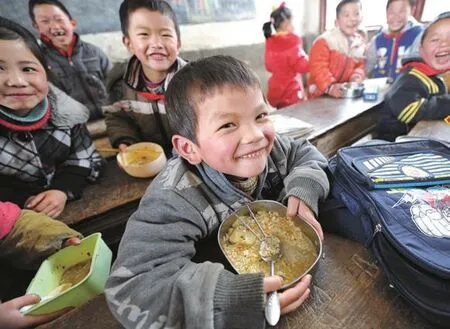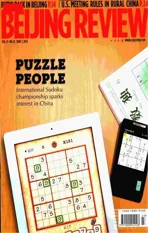Hands Together
2012-09-12ByYuanYuan
By Yuan Yuan
China is trying more ways to connect NGOs with public foundations
Hands Together
By Yuan Yuan
China is trying more ways to connect NGOs with public foundations

hAppY SMiLES: Students in a primary school in Wuchuan County, southwest China’s guizhou province, have free lunch on March 15
In March 2011, Liang Shuxin, a marketing planner at online community Tianya.cn and founder of Micro Foundation in Guangzhou, south China’s Guangdong Province, started an online fundraising program to sponsor students in Hongban Primary School in Qianxi County, southwestern Guizhou Province.
Micro Foundation is a non-government organization (NGO) founded in 2010 with the aim of harnessing the power of the Internet to help students living in poverty-stricken areas. After he learnt from a TV program that two thirds of students in some rural areas weren’t eating lunch, Liang began to sell virtual lunches priced at 5 yuan ($0.79) apiece on Taobao.com, China’s largest C2C site. He told netizens that a donation of 5 yuan could buy lunch for a child.
The donations enabled 374 students in two primary schools in Qianxi County to have free lunches, but Liang was facing a new problem.
“We didn’t have an offcial identifcation to collect donations,” Liang said.
At frst, the money Liang raised online all went to his personal account. He was eager to fnd a transparent way to show donors how the money was spent.
The same happened to Deng Fei, a veteran journalist from Phoenix Weekly news magazine, who is better known as the founder of the charity program Free Lunch for Children.
During a reporting trip in February 2011 to Guizhou, Deng was shocked to discover that quite a few schools in the province’s rural areas had no canteens for students. The students had nowhere to eat lunch and were hungry during their afternoon classes. The children were so weak from hunger that many schools simply cancelled physical education lessons in the afternoon.
On March 9, 2011, Deng and 500 other media workers initiated the program. But Deng, who initially just wanted to help the schools he visited, soon realized that there are a far larger number of needy students. “The bottleneck for us to carry on is we don’t have any qualifcation to collect money,” Deng said.
根据现有的研究结论和理论基础,针对影响并购支付方式的因素,本文从市场因素、交易因素和公司因素三个方面探讨上市公司并购支付方式的决定因素。其中,市场因素包括商业周期和市场利率。交易因素包括交易规模和交易态度。公司因素包括财务杠杆、公司规模、成长机会和股权集中度。
According to China’s Regulations on Administration of Foundations, only government-sponsored foundations are allowed to collect donations from the public. Organizations like Micro Foundation and Free Lunch for Children are not allowed to solicit donations, but are fnding new ways to cooperate with government-sponsored foundations to secure funding.
All the good news
Just as Liang was struggling to think of how to carry on, the Guizhou Youth Development Foundation, a public foundation, offered a solution. Yang Zhen, Secretary General of the foundation, contacted Liang to discuss cooperation.
On April 3, 2011, the Guizhou Youth Development Foundation and Tianya.cn relaunched the Micro Foundation with the aim of improving conditions for rural primary school students in Guizhou. The new foundation has the qualifcation to collect donations from the public. The Guizhou Youth Development Foundation is in charge of supervising the usage of the donations to ensure they are all spent on the students.
“Liang and his group have more experi-ence in organizing charity activities online and they know how to do it effectively,” Yang said. “I think our cooperation can provide a new way to boost charity in China.”
In early April 2011, Deng also had good news. The China Social Welfare Foundation offered to cooperate with the Free Lunch for Children program.
On April 8, at a ceremony marking the frst anniversary of the Free Lunch for Children program, Deng announced that the program had already raised 24 million yuan ($3.77 million) and sponsored 17,000 students.
On October 26, 2011, Premier Wen Jiabao said that the Central Government would allocate 16 billion yuan ($2.51 billion) worth of nutrition subsidies to village schools in 680 counties, but this does not cover children who attend preschool classes and teachers. Deng said that the Free Lunch for Children program would cover the latter group.
Both Deng Fei and the China Social Welfare Foundation shared the belief that they can achieve more through working in partnership.
“This is an important attempt to explore ways that a public foundation can be combined with a private charity program,” said Miao Li, Secretary General of the China Social Welfare Foundation.
Breaking the ice
The cooperation between NGOs and public foundations used to be very rare. The ice was really broken following the 8.0-magnitude Wenchuan earthquake in southwest China’s Sichuan Province in May 2008, which killed nearly 70,000 people and left millions of people homeless.
After the disaster, the Red Cross Society of China (RCSC) received over 1.3 billion yuan ($204 million) in donation but found it diffcult to manage the money effectively by itself. On pilot basis, the society allocated 20 million yuan ($3.14 million) to 17 NGOs, which were selected through public tender procedures to help with 17 reconstruction projects.
The Shaanxi Women’s Research Association got 1.45 million yuan ($227,776). As one of China’s oldest and best known NGOs, the association was founded in 1986 and registered as a social organization in 1999.
The association used the money to build 36 buildings for quake survivors. More importantly, it developed three different types of low-cost temporary facilities to fit the needs of earthquake-affected areas.
An education-focused NGO, Student Action, began its relief efforts in the disaster area immediately after the earthquake. In the heavily hit region of Pengzhou, it provided schools with emergency lighting systems, lightning protection systems, electric fans and other facilities.

LiFE oN tRACK: Children play table tennis in a village in Mianzhu City, soutwest China’s Sichuan Province, which was rebuilt after the Wenchuan earthquake in May 2008. Many NGOs participated in the post-quake reconstruction
In order to meet the needs of bereaved and displaced children, Student Action, with 500,000 yuan ($78,470) from the RCSC, also set up a New Summer Life activity center in Pengzhou. With the help of university student volunteers, the center hosted fun interactive programs for local children, aimed at reducing the negative psychological impact of the earthquake and its aftermath.
On May 16, an evaluation report of the 17 projects was released in Beijing by the RCSC and the Center for Civil Society Studies of Peking University. The report says that 12 out of 17 projects prove to be successful.
“This has provided a model for cooperation between NGOs and governmentsponsored foundations,” said Guo Changjiang, Vice President of the RCSC.
Challenges
According to the China Foundation Center, there are now 1,324 private foundations operating in China, 131 more than the number of public foundations.
“This means private foundations will inevitably cooperate more with government-sponsored ones,” said Secretary General Yang of the Guizhou Youth Development Foundation.
“NGOs currently rely more on volunteers, whose executive abilities vary and this could cause some problems,” said Liu Neng, a professor of Sociology at Peking University and also a member of the evaluation team on the 17 post-Wenchuan earthquake reconstruction projects by NGOs. “Besides, when they spread their programs to a new place, they tend to adopt the methods they used before despite the new environment. This may also negatively affect the programs’ implementation.”
Liu took an “unsuccessful” project out of the 17 projects for example. A NGO called Wild Grass from Chengdu, Sichuan, planned to build eco-friendly toilets for 150 rural households in the quake-hit area. But as they were not familiar with the local environment and couldn’t communicate well with the local government, their project didn’t proceed well.
“Both NGOs and government-sponsored foundations have their advantages, and we should combine the advantages together and make the cooperation work in a much more effective way,” said Yang Tuan, Deputy Director of the Social Policy Research Center of the Chinese Academy of Social Sciences.
The Center for Civil Society Studies of Peking University suggested there should be a third party to supervise and evaluate such cooperation.
yuanyuan@bjreview.com
